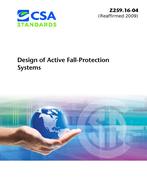PDF version is text searchable.
1 Scope
1.1This Standard is intended for professional engineers with expertise in designing fall-protection systems. It specifies requirements for the design and performance of complete active fall-protection systems, including travel-restraint and vertical and horizontal fall-arrest systems.
1.2This Standard is not intended as a substitute for testing and certification of individual components of fall-protection equipment in accordance with applicable CSA Z259 equipment Standards.
1.3This Standard does not cover the design of passive fall-protection systems such as guardrails and nets, except where such passive systems are also designed to serve as anchorage and/or anchorage connector subsystems for active fall-protection systems covered by this Standard.
1.4This Standard does not cover the design of positioning systems.
1.5This Standard does not cover the determination of structural strength and behaviour of components or anchorages of active fall-protection systems. It does, however, establish the safety criteria once the strengths and behaviours are known. Such strengths and behaviours are determined by analytical testing or engineering methods and by CSA or other design Standards for the materials and structural systems being used.
1.6This Standard does not specify design or performance requirements for fall-arrest equipment or systems that have been manufactured and successfully tested in accordance with the requirements of another CSA Z259 Standard.
1.7This Standard does not supersede the requirements of applicable occupational safety and health regulations. Where the requirements in this Standard differ from legislated requirements, the most conservative requirement is followed.
1.8In CSA Standards, “shall” is used to express a requirement, i.e., a provision that the user is obliged to satisfy in order to comply with the standard; “should” is used to express a recommendation or that which is advised but not required; and “may” is used to express an option or that which is permissible within the limits of the standard.
Notes accompanying clauses do not include requirements or alternative requirements; the purpose of a note accompanying a clause is to separate from the text explanatory or informative material.
Notes to tables and figures are considered part of the table or figure and may be written as requirements. Legends to equations and figures are considered requirements.
Product Details
- Published:
- 02/01/2004
- Number of Pages:
- 58
- File Size:
- 1 file , 720 KB
- Product Code(s):
- 2416791, 2015007
